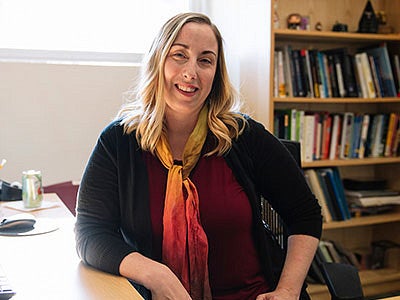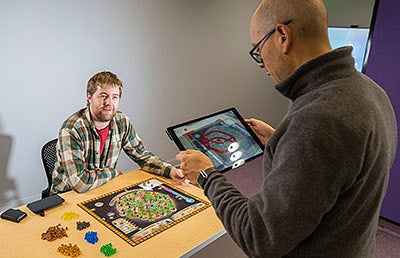The SOJC’s Center for Science Communication Research aims to make complex science—about climate change, wildfires, COVID-19, and more—useful to the public.
Over the years, the barriers between those who conduct science and those who benefit from it have grown taller and wider. As issues such as climate change and COVID-19 are increasingly politicized, it has become clear that scientific knowledge is useful only when we are aware of it, understand it, and apply it to our lives.
The Center for Science Communication Research (SCR) aims to make science more widely accessible by enhancing the conversation between scientists and society. Founded in 2017 in the School of Journalism and Communication (SOJC) with funding from the UO Presidential Fund for Excellence, the center connects collaborators across campus and the world to research the most effective ways to communicate science to the public.
Working with SCR presents unique opportunities for graduate and undergraduate students to learn about science communication and gain experience in science communication research.
Attracted in part by the center’s interdisciplinary nature, Karikarn (Kay) Chansiri moved to the United States from Thailand to pursue a PhD in communication and media studies at the SOJC. She works with Ellen Peters, Philip H. Knight Chair and director of SCR, to explore how Americans’ skill and confidence with numbers predict their perceptions of health risks as well as their behaviors.
“I have been interested in science since I was young,” Chansiri said. “[I thought] ‘Why don’t I combine social science and science?’ And that got me interested in science communication, which basically just wants to communicate science and scientific findings to other people.”
By making science understandable, Chansiri and the rest of SCR’s researchers work to help people make informed decisions about how to stay healthy, where to put their money, who to trust, how to act on climate change, and how to generally lead better lives. Those decisions were always important, but in a year full of climate and public health catastrophes, SCR’s mission to make complex science useful has become even more critical.

Areas of SCR Research
Image
Health Communication
Image
Environmental Communication
Image
Science and Technology
Image
Judgment and Decision-Making
Image
Creative Inquiry
Image
Open Communication about Public Health Saves Lives
Developing transparent and authentic health communication can strengthen the relationships between researchers and community members, which is especially important during a pandemic. As the coronavirus flipped life as we knew it upside down, SCR researchers began examining how people make health decisions in the face of a public health crisis.
Peters is a leading coronavirus expert at the UO, working with colleagues across campus to share and disseminate information about the progressing pandemic. Much of her research also explores the foundations of human judgment and decision-making: emotions and numeric literacy, which is like reading literacy, but with numbers. Her results support the critical importance of presenting numbers in understandable formats so that people can use them effectively.
One of her primary goals for the center is establishing collaborations with researchers in the SOJC, across UO, and at other research institutions.
“SCR is building a transdisciplinary group of scholars who merge evidence and story to promote scientific and numeric literacy in the public,” Peters said. “Ultimately, by understanding communication processes and effective messages better, we can engage a more knowledgeable public who can make better decisions about critical problems we face as Oregonians and as a nation.”
Public relations associate professor Autumn Shafer collaborates with Chansiri and Peters on health communication research. Shafer often includes students in her work, which focuses on the social, theoretical, and practical issues related to public health promotion.
She credits the center’s collaborative culture for expanding her research opportunities.

“My experience with the SCR has been transformative,” said Shafer, who is one of many recipients of the center’s small research grants. “Through the SCR, I was introduced to a research team at Oregon Health & Science University. This introduction two years ago has led to multiple research collaborations and a recent National Institute of Health funding award.”
Shafer is working with SOJC students to implement a communication strategy for the Healthy Oregon Project, which helps Oregonians better understand their risks for cancer and chronic diseases. The study aims to strengthen the relationship between scientists and the public to answer important health questions.
“One out of every 100 Oregonians has a genetic cancer risk that changes the way their doctor should handle their care. Of those at risk, most don't know it,” Shafer said. “The Healthy Oregon Project is committed to identifying those individuals and letting them know what they can do to reduce their risk. Every participant in the Healthy Oregon Project helps advance our understanding of the causes of cancer and the importance of early detection.”
Image
Driving Conversations about Climate Change
Environmental communication shapes how we view natural systems and humans’ role in them. SCR researchers illuminate the importance of understanding environmental issues and communication’s impact on people’s beliefs and actions.

SCR associate and advertising associate professor Troy Elias examines how different groups react to—and act on—messages about climate change. His research found people of color are as concerned or more concerned about climate change than white people, but their contributions to the climate change movement remain mostly unrecognized by the media and advertisers.
“Regardless of the degree of need or circumstances within racial-ethnic minority groups, their level of environmental concern supersedes or is commensurate with white Americans,” Elias said. “The amount and type of media these groups consume—conservative or nonconservative news—have associations with their environmental attitudes and behavioral intentions in ways that are not uniform across their racial-ethnic identities.”
SCR’S founding researcher Hollie Smith, assistant professor of science and environmental communication, explores people’s responses to environmental risk and media coverage. She is leading a study funded by the United States Geological Survey to determine how to shift public behavior around climate change across Oregon communities of varying socioeconomic status.
She also works with students in many ways, including teaching a unique wildfire communication course through the Clark Honors College that helps students explore fire through storytelling.
“I love working with undergraduate and graduate students through all stages of research and writing,” Smith said. “When students are involved, they help with every aspect of research: data collection, analysis, and writing. Working together allows us all a time to grow and see things from new perspectives.”
The Fire Story Podcast
SCR is looking at the public’s connection to wildfires through media and science communication. Hosted by SCR associate director Mark Blaine and founding researcher Hollie Smith, The Fire Story podcast brings together wildfire experts from diverse backgrounds to discuss the science of communication during a fire event, fire preparedness techniques, the complexities of wildfire response, and how communities and the landscape recover after a fire.
The series gives communication professionals and the public a more nuanced understanding of wildfire’s multiple dimensions through the lens of recent wildland fires in Oregon.
Image
Gender Exclusivity in the Gaming World
Media studies assistant professor Amanda Cote is an expert in game studies, gender, and representation in the gaming industry. Her animated video, From Digital to Dungeons: What the video game industry can learn from D&D, details how most video games are framed as a technology for boys more than girls. Her recent book, Gaming Sexism, also explores the misogyny embedded in video game culture, while her research has helped shape the SOJC’s cutting-edge game studies curriculum. In this video, Cote emphasizes how including diverse stories and characters in video games would reach a wider audience and result in better sales.
Image
Engaging Communities through Creativity
While many of those who work with SCR focus on traditional scientific research methods, others use a more creative approach to share information.

In January 2020, SCR hosted a Climate Change Game Night where students could play and provide feedback on games meant to help people retain climate change information. Journalism master’s student Robin FitzClemen debuted his culminating project Wildfire, a board game that lets players take wildfire management into their own hands by rolling dice to determine how to contain the fires burning across the board.
Outside the classroom, SOJC students can develop practical science communication skills and witness a warming planet’s impact firsthand through Science & Memory. Housed in the SCR, this faculty-led experiential learning program takes students to locations around the world, from the Oregon Coast and Alaska to Hawaii and Ghana, to tell complex stories about adaptation to climate change.
Professor of practice and SCR assistant director Mark Blaine cofounded Science & Memory with his SOJC colleagues Deborah Morrison, Dan Morrison, and Torsten Kjellstrand. He also co-led with Kjellstrand River Stories, a series of classes that took students into the field to learn, observe, film, and create stories about the Willamette River and those who live within its ecosystem.
Blaine is curious about how storytelling helps communicate scientific information to the public and how scientists can humanize data and statistics with empathy and accessibility. He is working on a documentary series called A Kayak to Carry Us that shows how learning to build a traditional Sugpiaq kayak can help Native children maintain and invigorate their language, culture, and way of knowing the land and the ocean.
“The SCR is really coming together at a critical time in society,” Blaine said. “A year ago I would have said science held a high level of public trust, but the circumstances of the public response to coronavirus have me questioning what those attitudes are now. If there was ever a time when we needed public trust in science, it’s today.”

Spotlight on SCR Research Associates
Hollie Smith
Troy Elias
David Markowitz
Donna Davis




